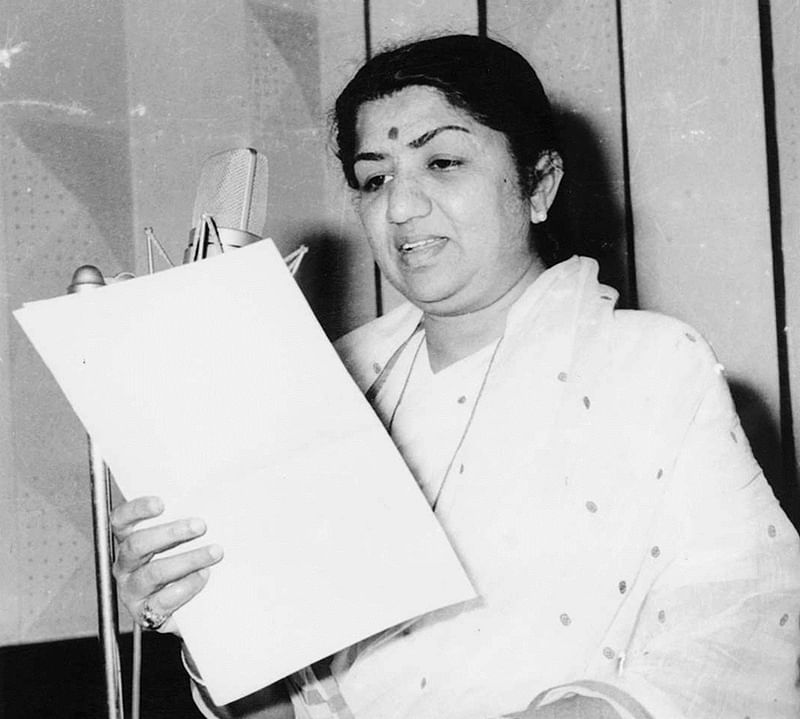

Lata Mangeshkar is synonymous with the Hindi film song - and then some - so it is futile to greet her with banal superlatives, no doubt all of which she richly deserves.
Her oeuvre is magnificent in its breadth and quality, her voice appeals to people across generations, and the great longevity of her songs is beyond dispute, with songs she sang 7 decades ago still occupying a place in the public imagination.
While her facility with Urdu talaffuz is legendary, in no small measure aided by her hard work, it is noteworthy that she has sung in a large number of languages, with an enviable degree of success. This has added to her immense popularity across geographical and linguistic boundaries.
The mainstay of her music is her work for Hindi films. She had a very long career but one could argue that the 1950s were the best years of her career. She was at the peak of her virtuosity, and she worked with some of the greatest composers of the time, not limited to the big commercial names. It is difficult to pick one or a few songs from even that truncated period, but let us take a peek into that era. In 1951, she sang the delectable Yaman-based composition of Jamal Sen for Shokhiyan, ‘supna ban saajan aaye’, overshadowing the voice of the heroine Suraiya. The following year she sang ‘woh to chale gaye ai dil’ for the eccentric genius Sajjad Hussain composing for Sangdil. I cannot resist picking one of Anil Biswas’ compositions, ‘ik pal ruk jaanaa, jaanewale raahi’ for Rahi (1953) although he was definitely one of the star composers in those days. The following year, the scarcely-known composer Sailesh gave her the heartbreaking ‘jal ke dil khaak huaa’ in Parichay. This is an endless list, with practically every song she sang turning out to be a glittering gem!
She was quite prolific in Marathi, and sang outstanding songs both for films and private albums. Her collaboration with three Vasant-s - Prabhu, Pawar, and Desai are noteworthy. She also sang for many others, including Srinivas Khale and her brother Hridaynath Mangeshkar in later years. But standing alone are the compositions that she sang for herself. She composed the music for 5 Marathi films, 4 of them under the pseudonym Anandaghan. The compositions are of a very high caliber, sample the lilting ‘bai bai man-moraacha kasa pisaara phulalaa’ for the 1963 film Mohityanchi Manjula. Her Bengali output is substantial, next to Marathi in volume. She has sung for films but the best of her work falls under the Adhunik Gaan category, i.e. private songs. There are many great songs to choose from, but the Bengali original of the Anand song ‘jiyaa laage naa’, composed by Salil Chowdhury, ‘naa mono laage naa’ is an eternal favorite.
In her Gujarati songs, she makes up in quality what is, somewhat surprisingly, lacking in quantity. As a personal favorite, I would like to pick her very first song, ‘have sakhi nahin bolun’, composed by Purushottam Upadhyay, which is sung in a honey-dipped timbre. At the other corner of the country, she had sung the haunting ‘jonakore rati’ for Era Bator Sur (1956), composed by the Assamese icon Bhupen Hazarika. Moving westwards along the mountains, we come across the somewhat modern lori ‘tu malla tu’ in Dogri, penned by the redoubtable Padma Sachdev. The composition also evokes the mountains but in a distinctly Dogri style.
She has sung only 2 songs in Kannada, both for the 1967 film Sangolli Rayanna, composed by Lakshman Beralekar. The song ‘bellane belagayithu’ is composed and sung beautifully. Opinion is divided on the quality of her pronunciation, with some fans insisting she is singing in a Northern Karnataka accent. Nevertheless, the beauty of the song itself is unmistakable. She had sung quite a bit earlier in two neighboring states. ‘nidurapora thammuda’, the Telugu lori from Santhanam (1955), is a duet with the great Ghantasala. A Tamil song ‘endan kannalan’ from 1956 is a bit of a cheat since it is the dubbed version of the Uran Khatola song ‘mere sai.nyani utrenge paar’, but she has sung it very well.
The first film in the Nepali language was Maitighar (the Nepal-born star Mala Sinha was instrumental in making it). It was an ambitious project, with most of the top singers from Hindi films roped in to record songs. The fabulous music was by Jaidev. Lata Maneshkar sang the evocation ‘jun mato ma mero’, the lyrics having been written by the Nepal-Naresh himself. Crossing over to the other end of the subcontinent we come across the Sinhalese song ‘Sri Lanka maa priyadara jaya bhoomi’ that is resplendent in patriotic glory.
This quick tour of the map demonstrates the versatility and popularity of Lata-didi. Most of the songs are top-notch in musical value, with impeccable pronunciation, and masterful execution. This is but a glimpse of her greatness, encapsulating the reasons for the love that the people of the region have for her.
(*Read the original Deccan Herald article here.)
Author info is not available!